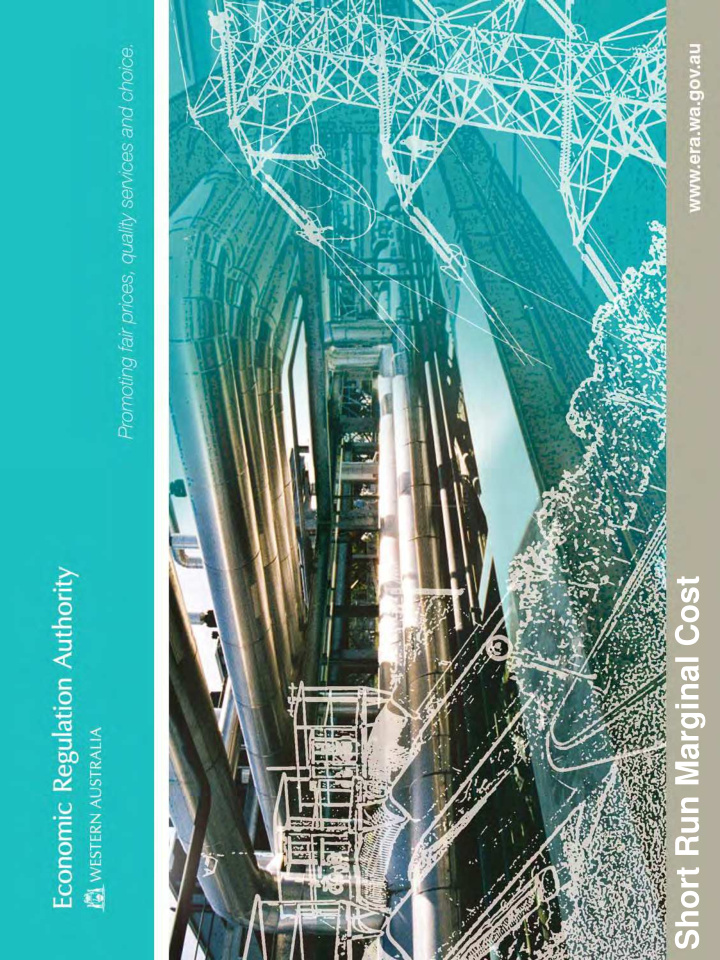



Short Run Marginal Cost
Short Run Marginal Cost K Peter Kolf General Manager Economic Regulation Authority SRMC Forum 26 February 2008
Important Notice • This document has been made available in good faith by the Economic Regulation Authority (Authority). This document is not a substitute for professional advice. No person or organisation should act on the basis of any matter contained in this document without obtaining appropriate professional advice. • The Authority and its staff members make no representation or warranty, expressed or implied, as to the accuracy, completeness, reasonableness or reliability of the information contained in this document, and accept no liability, jointly or severally, for any loss or expense of any nature whatsoever (including consequential loss) arising directly or indirectly from any making available of this document, or the inclusion in it or omission from it of any material, or anything done or not done in reliance on it, including in all cases, without limitation, loss due in whole or part to the negligence of the Authority and its employees. This notice has effect subject to the Trade Practices Act 1974 (Cwlth) and the Fair Trading Act 1987 (WA) , if applicable, and to the fullest extent permitted by law. • Any summaries of legislation, regulations or codes in this document do not contain all material terms of those laws or obligations. No attempt has been made in the summaries, definitions or other material to exhaustively identify and describe the rights, obligations and liabilities of any person under those laws or provisions.
Overview – Purpose of SRMC Papers & Workshop – Role of ERA & IMO – Compliance requirements of the Rules – Basic Economics – Relevant costs – Optimal Portfolio SRMC
Role of ERA and IMO – Monitoring – Investigate – Publish results within 20 days – Refer to Energy Review Board (Sections 2.16.9 and 6.6.3 Rules)
Role of ERA and IMO In summary, the Authority, with the assistance of the IMO, is responsible for monitoring the effectiveness of the market in meeting the Wholesale Market Objectives and must investigate any market behaviour if it considers that the behaviour has resulted in the market not functioning effectively. If a firm with market power submits a portfolio supply curve that does not reflect that firm’s reasonable expectation of SRMC for any given trading interval and the Authority determines that to be the case, the matter must be referred by the IMO to the Energy Review Board requesting that a civil penalty be imposed on the relevant market participant.
Compliance requirements of the Rules – Reasonable expectations of SRMC • Market power • Relevant electricity • Market not functioning effectively • Meeting the Wholesale Electricity Market objectives – Inappropriate or anomalous market behaviour – Exploitation of shortcomings in WEM Rules – Reasonable expectations wrt availability declarations – Reasonable expectations wrt fuel declarations – Etc.
Economic Efficiency – Technical – Allocative – Dynamic (long run) • Inefficient markets waste resources
Electricity Interests of Consumers Optimum All other commodities
What is Short run Marginal Cost? The change in short run total cost (C’) for an extremely small change in output (Q).
Distinction between Short Run and Long Run Marginal Costs – Only superficially about the notion of time – The long run is how long it takes for the technologically feasible mix of inputs to be changed
Costs Ain’t Costs – SRMC not “fair value” – SRMC is not necessarily what you pay but – it’s what it really costs the organisation Take fuel: – If 100% take or pay & use it or loose it ⇒ SRMC ≈ 0 – If pay as you use, no loss of inventory & no secondary market ⇒ SRMC ≈ what you pay for it – If pay as you use, no loss of inventory & secondary market ⇒ SRMC ≈ opportunity cost
What Costs? – Variable costs – Avoidable costs – Direct / indirect costs – Fixed costs – Joint costs – Sunk costs – Overhead costs – Opportunity costs
Types of costs
What is a sunk cost? – A sunk cost is a fixed cost that cannot be avoided in the short run – In the long run there are no sunk costs
What is an Opportunity Cost? • Potential benefits foregone to create greater benefits
Avoidable Fixed Cost vs Shutdown Cost? – Avoidable fixed cost is zero when output is zero (eg start-up cost) – Shutdown cost is opposite to avoidable fixed cost (eg non-zero if plant is shut down)
Identification of costs
Generation technologies – Electricity output over 2 trading days
Generation technologies – Electricity output over 5 trading intervals
Short Run Total Cost Curve – Plant with Sunk Start-Up Costs and Small Shutdown Costs Slope of tangents = SRMC Small shutdown costs
Short Run Marginal Cost Curve – Plant with Sunk Start-Up Costs and Small Shutdown Costs
Short Run Total Cost Curve – Plant with Sunk Start-Up Costs and Large Shutdown Costs Slope of tangents = SRMC Large shutdown costs
Optimal Portfolio Short Run Marginal Cost Curve
Quantity Band Average Marginal Cost Approach
Supply and Demand Portfolio $ Portfolio Supply Curve (offers) P Producer Surplus Portfolio Demand Curve (bids) q MWh
Concluding Remarks • Questions • Comments
Economic Regulation in Energy
Recommend
More recommend